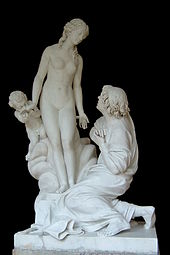- Galatea (mythology)
-
- For the Sicilian nereid in love with Acis, see Acis and Galatea (mythology)
- For the wife of Lamprus, who prayed to Leto that her daughter be turned into a son, see Leucippus (mythology)
Galatea (Greek: Γαλάτεια; "she who is milk-white")[1] is a name popularly applied to the statue carved of ivory by Pygmalion of Cyprus in Greek mythology. An allusion to Galatea in modern English has become a metaphor for a statue that has come to life. Galatea is also the name of Polyphemus's object of desire in Theocritus's Idylls VI and XI and is linked with Polyphemus again in the myth of Acis and Galatea in Ovid's Metamorphoses.
Contents
Name "Galatea"
Though the name "Galatea" has become so firmly associated with Pygmalion's statue as to seem antique, its use in connection with Pygmalion originated with a post-classical writer. No extant ancient text mentions the statue's name.[2] As late as 1763, a sculpture of the subject shown by Falconet at the Paris Salon (illustration) carried the title Pygmalion aux pieds de sa statue qui s'anime, "Pygmalion at the feet of his statue that comes to life".. That sculpture, currently at the Walters Art Gallery in Baltimore, now bears the expected modern title Pygmalion and Galatea.
According to Meyer Reinhold, the name "Galatea" was first given wide circulation in Jean-Jacques Rousseau's scène lyrique of 1762, Pygmalion. The name had become a commonplace of pastoral fictions, because of the well known myth of Acis and Galatea; one of Honoré d'Urfé's characters in L'Astrée was a Galatea, though not this sculptural creation.
 Falconet's 1763 sculpture (Walters Art Gallery, Baltimore)
Falconet's 1763 sculpture (Walters Art Gallery, Baltimore)
Myth
The story of Pygmalion appeared earliest in a Hellenistic work, Philostephanus' history of Cyprus, "De Cypro".[3] It is retold in Ovid's Metamorphoses,[4] where the king Pygmalion is made into a sculptor who fell in love with an ivory statue he had crafted with his own hands. In answer to his prayers, the goddess Venus, (Aphrodite) brought it to life and united the couple in marriage. This novella remained the classical telling until the end of the seventeenth century. The trope of the animated statue gained a vogue during the eighteenth century.[5]
The daemon of Pygmalion's goddess, animating her cult image, bore him a son Paphus—the eponym of the city of Paphos—and Metharme. Of "this ecstatic relationship," Meyer Reinhold has remarked, "there may be lurking a survival of the ancient cult of the Great Goddess and her consort."[6]
Cinyras, perhaps the son of Paphus, ([7]), or perhaps the successful suitor of Metharme, founded the city of Paphos on Cyprus, under the patronage of Aphrodite, and built the great temple to the goddess there.
Bibliotheke, the Hellenistic compendium of myth long attributed to Apollodorus, mentions a daughter of Pygmalion named Metharme.[8] She was the wife of Cinyras, and the mother of Adonis, beloved of Aphrodite, although Myrrha, daughter of Cinyras, is more commonly named as the mother of Adonis.
It was commonly rumored in Roman times that Praxiteles' Aphrodite of Knidos, the cult image in her temple was so beautiful that at least one admirer arranged to be shut in with it overnight.[9]
Interpretation
The myth incontrovertibly indicates that a cult image of Aphrodite was instrumental in some way in the founding myth of Paphos. It also seems axiomatic, apart from miraculous intervention, that the living representative of a cult image could be none but the chief priestess. Robert Graves gives a socio-political interpretation of the story, as a mythologized overthrow of a matrilineal cult. In his view Pygmalion, the consort of the goddess's priestess at Paphos, kept the cult image of Aphrodite as a means of retaining power during his term, after which, Graves speculates, he refused to give up the goddess's image "and that he prolonged this by marriage with another of Aphrodite's priestesses—technically his daughter, since she was heiress to the throne—who is called Metharme ("change"), to mark the innovation."[10]
Pygmalion is the Greek version of the Phoenician royal name Pumayyaton: see Pygmalion of Tyre.
See also
- Galatea of Justice League Unlimited
- Galatea (video game), a work of interactive fiction
- List of Metamorphoses characters
- Pygmalion and Galatea (play, 1871).
- Pygmalion (mythology)
Notes and references
- ^ Galene in the Smith Classics Dictionary. The suffix -teia or -theia means "goddess", as in other Nereid names: Amatheia, Psamathe, Leukotheia, Pasitheia, etc. Hesiod has both a Galene ("Calm-Sea") and a Galateia named as Nereids. Galateia as "sea-calm Goddess" seem a likely inference; the reasoning for Galateia as Milky-White comes from the adjectival form of galaktos, galakteia.
- ^ Helen H. Law, "The name Galatea in the Pygmalion myth" The Classical Journal, 27 (1932), pp 337-42; Meyer Reinhold, "The Naming of Pygmalion's Animated Statue" The Classical Journal 66.4 (1971), pp. 316-319: Reinhold notes that the first edition of Lemprière's Bibliotheca classica, 1788, does not have an entry for "Galatea", which was inserted in later editions.
- ^ Reinhold 1971:316.
- ^ Metamorphoses x.243ff.
- ^ J.L. Carr, "Pygmalion and the philosophes: the animated statue in eighteenth-century France" Journal of the Warburg and Courtauld Institutes 23 (1960), pp 239-55.
- ^ Reinhold, eo. loc..
- ^ According to the Roman Hyginus, Fabula 142, Cinyras was a son of Paphus, thus legitimate in the patrineal manner, but Bibliotheke makes Cinyras an interloper, arriving with some of his people from Syria on the nearest coast of Asia, thus a suitor from outside, in the matrilineal manner; the conflict is instructive.
- ^ Bibliotheke, iii.14.3.
- ^ Recorded in the second-century dialogue Erotes that is traditionally misattributed to Lucian of Samosata.
- ^ Graves, Robert (1960). The Greek Myths. pp. 64.1. ISBN 0140171991.
External links
- Galatea depicted with Polyphemus on a golden harpsichord by Michele Todini, Rome, 1675 at The Metropolitan Museum of Art
Categories:
Wikimedia Foundation. 2010.
